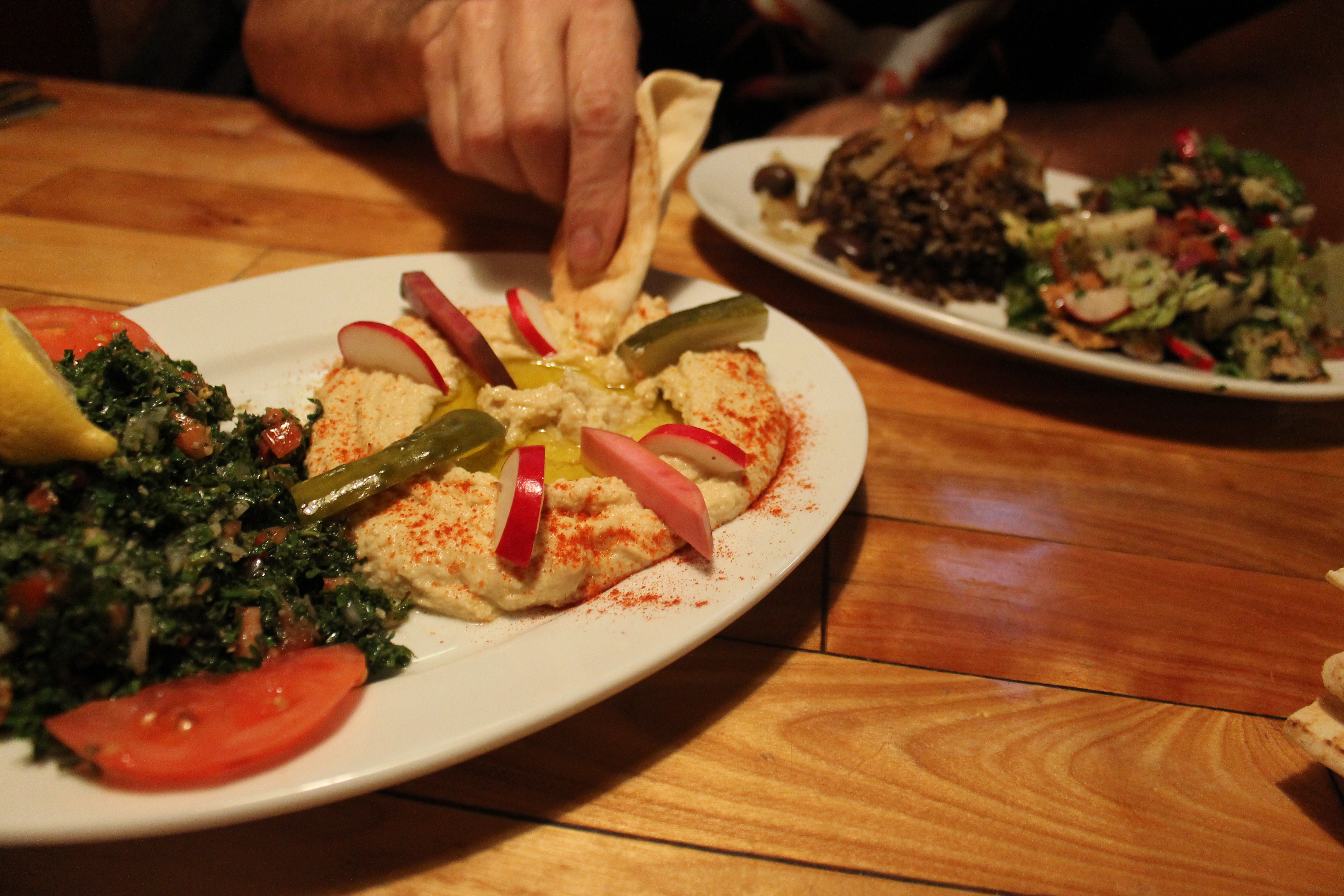97.4% of the population of Prince Edward Island is white. It is thought to be the most Scottish place in the world outside of Scotland, with an estimated 50% of islanders having Scottish roots. The preferred coffee of PEI is a Tim Horton’s double double (that’s double cream, double sugar), hockey is more important than God—but only by a smidge—and Anne of Green Gables is the patron saint.
So how did a Lebanese place opened in 1979 end up being the longest-running family restaurant in the province?
Videos by VICE
The first time I visited Cedar’s Eatery I ordered fries. Turns out a lot of my brethren did as well. We came for the fries, we stayed for the hummus, and the falafel, and the shawarma, and that incredibly addictive garlic sauce that comes with the house chicken. Those fries were the gateway drug that granted us entry to the rest of the menu—to the kefir and the stuffed grape leaves. Worlds away from the clam chowder we grew up with.
It should be noted that we have the prerequisite Chinese-Canadian restaurant, the Canton Café, and it is still going strong. A few other Lebanese places have popped up as well; Shaddy’s, for example, has been dishing up shawarma since the mid-80s. In recent years a sushi place, two Indian joints, and a Thai place have opened, making the island’s restaurant offerings a little more global these days. But back in 1979, hummus was a novelty.

“To make everybody happy we started with fries and burgers, to make it a Canadian-Lebanese menu,” says Maroun Abdallah, who, with his wife Nawal, took over the restaurant from her brother Fouad “Freddie” Yammine, who’d started it. “Through the years we would add to the Lebanese food a little bit,” he continues. “We’d launch a new item; put it on special,” adds Nawal.
I wonder how one would even begin to explain tabbouleh to an islander at a time when you couldn’t find something as basic as olive oil in the grocery stores (PEI at the time being the land of margarine). In the 80’s the Abdallahs were getting most of their ingredients shipped in: not just the pine nuts, grape leaves, and cracked wheat for kibbeh but also ingredients as seemingly basic as olive oil, dried chickpeas, and pita bread.

“When we started we used to put hummus or tabbouleh or kebab on special, but the customers didn’t know what it was. They would ask, what’s hummus? What is it made of?” says Maroun, “Now everybody in North America knows what hummus is, but back then we had a difficult time explaining the ingredient.”

When Maroun and Nawal tell me that it was very hard to get any traction with those early Lebanese dishes I am not surprised at all, but I imagine Cedar’s must have been embraced by the Lebanese community.
“No,” says Nawal, “they don’t go out to eat Lebanese food. They cook their own food at home—when they go out, they want something different.” The Abdallah’s plan was always to get the islanders on board. But this was an island of fishermen who ate fish sticks. They didn’t even eat their own catch. How do you convert diners like that?
The answer is simple: hire local island girls, get them on board with the tastes of tahini, lemon, grape leaves, and loads of fresh parsley, then let them loose on the tables of fish and chip–heads.

Once that army of island girls had chatted up the menu items and the customers actually tried them, that was the test. Would they like it, or would they run for their lobster traps, never to darken the door again?
Nawal smiles broadly, “They became repeat customers.”
One fisherman at a time.
Rod Weatherbie, a former manager, remembers going there as a kid at 13. “My mom tried to be adventurous in the kitchen but we certainly never had Middle Eastern food. I was nervous the first time I went. I didn’t know what any of the dishes were. We would get an order of fries and an order of hummus and dip the fries in the hummus. That garlic sauce with the house chicken! Everything was so good, all made from family recipes.”

“I think it has a lot to do with the level of acceptance that had occurred previously,” says David Weale, author of Stream Out of Lebanon, a book published by the Institute of Island Studies that documents Lebanese immigration to the island. “By 1979, the Lebanese were accepted as members of the community and they opened Cedar’s at the right time—that was when people started eating in restaurants.”
Maroun’s brother Freddie explained further: “The whole community here is from just a few towns in South Lebanon: El Kefeir, Habaya, Deir Mimas and Marjayoun. And all of the Lebanese people here are Christian. That’s why they found it easy to integrate. We didn’t have any difference in our holidays—Christian culture, Christian values.”
But he admits that integration took awhile. “At first we felt like outsiders. People would single us out, because we were the only non-European ethnic community here. That changed with the second generation.”

It sure did. The island’s Premier (equivalent of an American governor) from 1986-1993 was the son of Lebanese immigrants. Joe Ghiz was the first premier of a Canadian province to be of non-European descent. PEI beat B.C. and Ontario (two provinces with massive and hugely diverse immigrant populations) in that regard. And then we loved Joe Ghiz so much we voted in his son Robert from 2007-2015.
READ MORE: How Chop Suey and Ginger Beef Helped Canada Discover Itself
And there’s one more thing that helped Cedar’s be accepted: hot chicken. “Nothing is more PEI than a hot chicken sandwich, and they served those with really great fries,” adds Weale. With locals working the floor, hot chicken to get people in the door, and a fully integrated Lebanese community, Cedar’s was off to a good start but it certainly wasn’t easy. This is the restaurant business after all.
Maroun and Nawal were in their early thirties when they arrived on the island. She’d been a secretary back in Lebanon, he’d done a little bit of cooking and serving in restaurants. They came to PEI, and within a year they were restaurant owners serving hummus to a population that had never heard of chickpeas, let alone tahini or even sesame seeds.
“Now, of course, hummus is ubiquitous but back in the day it was often the first step of a walk on the wild side, cuisine-wise.”
“Our staff was really good,” says Nawal, “And you have to make the server happy to sell your product. You have to make them love the food,” she continues. “And they did. It took four or five years, but it worked.” I ask if in those four or five long years if they ever thought about giving up.
“We never gave up. We always tried,” says Nawal, and when she says it, a haunted look crosses her face. It’s a look I’ve seen before, and only ever on the faces of independent restaurant owners.
Maroun explains that because there is so little opportunity for employment on the island that they did whatever they could to keep the place afloat. “More hours, hard work, and less payroll. We don’t hire more people, we do the work ourselves. Little by little, we made it work.”
WATCH: MUNCHIES Presents: Lebanon’s Lahmadjun
“PEI was all meat and potatoes all the time back then” says Ivy Wigmore, who, along with her sister, was a server at Cedar’s for almost twenty years. “Being an island, we were surrounded by seafood but even that wasn’t a staple in those days unless it was deep-fried. The burgers, fish and chips, and the hot chicken sandwiches sold really well, but it took a while for the Lebanese food to catch on.”
“A lot of people liked the kabobs or the house chicken. Neither is terribly unfamiliar but the spices and presentation were a just a little bit different and made people feel slightly adventurous, and the next time they might try something else. That’s how we hooked them.”
She adds that the real gateway dish was the hummus. “Now, of course, hummus is ubiquitous but back in the day it was often the first step of a walk on the wild side, cuisine-wise.”
Eventually the Abdallah children Shadi, Ghada, and Ryan started helping out—doing dishes and prepping. And in 1991 they opened the bar upstairs, Babba’s Lounge, which soon became one of the city’s go-to live music venues and an unofficial student hangout.

Ryan Abdallah remembers being in the kitchen at three years old. “I was sitting on the counter and my old man would say ‘ring the bell’ and I’d hit the bell for pick up. It started then: I did dishes and when I got old enough I worked in the dining room. As soon as I was 19 I wanted to bartend, so I was bartending upstairs for a few years and that’s where I first met my wife Laura.”
Ryan and Laura Abdallah want to keep running Cedar’s the way it always has been, with the same family recipes that have been passed down for generations, and they’ve even expanded to selling Maroun’s Garlic Spread in Sobey’s grocery stores across Atlantic Canada. I get my family to ship it to me from PEI, because even though I live in Toronto, the most multicultural city on earth, I can’t find Lebanese garlic sauce here, not the way the Abdallah family makes it.




